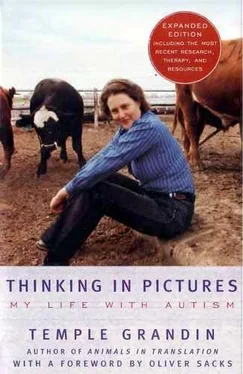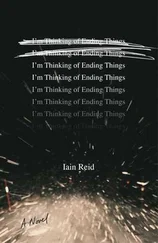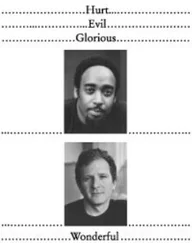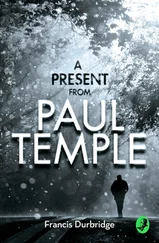I am now going to use what I call visual symbol imagery to help you understand how the different parts of the normal brain communicate with each other. Think of the normal brain as a big corporate office building. All the different departments such as legal, accounting, advertising, sales, and the CEO's office are connected together by many communication systems such as e-mail, telephones, fax machines, and electronic messaging. The autistic/Asperger brain is like an office building where some of the interdepartmental communication systems are not hooked up. Minshew calls this underconnectivity in the brain. More systems would be hooked up in an Asperger brain than in the brain of a low-functioning individual. The great variability in austistic/ Asperger symptoms probably depends on which «cables» get connected and which «cables» do not get connected. Poor communication between brain departments is likely the cause of uneven skills. People on the spectrum are often good at one thing and bad at something else. To use the computer cable analogy, the limited number of good cables may connect up one area and leave the other areas with poor connections.
Develop Talents in Specialized Brains
When I wrote Thinking in Pictures I thought most people on the autism spectrum were visual thinkers like me. After talking to hundreds of families and individuals with autism or Asperger's, I have observed that there are actually different types of specialized brains. All people on the spectrum think in details, but there are three basic categories of specialized brains. Some individuals may be combinations of these categories.
1. Visual thinkers, like me, think in photographically specific images. There are degrees of specificity of visual thinking. I can test run a machine in my head with full motion. Interviews with nonautistic visual thinkers indicated that they can only visualize still images. These images may range in specificity from images of specific places to more vague conceptual images. Learning algebra was impossible and a foreign language was difficult. Highly specific visual thinkers should skip algebra and study more visual forms of math such as trigonometry or geometry. Children who are visual thinkers will often be good at drawing, other arts, and building things with building toys such as Legos. Many children who are visual thinkers like maps, flags, and photographs. Visual thinkers are well suited to jobs in drafting, graphic design, training animals, auto mechanics, jewelry making, construction, and factory automation.
2. Music and math thinkers think in patterns. These people often excel at math, chess, and computer programming. Some of these individuals have explained to me that they see patterns and relationships between patterns and numbers instead of photographic images. As children they may play music by ear and be interested in music. Music and math minds often have careers in computer programming, chemistry, statistics, engineering, music, and physics. Written language is not required for pattern thinking. The pre-literate Incas used complex bundles of knotted cords to keep track of taxes, labor, and trading among a thousand people.
3. Verbal logic thinkers think in word details. They often love history, foreign languages, weather statistics, and stock market reports. As children they often have a vast knowledge of sports scores. They are not visual thinkers and they are often poor at drawing. Children with speech delays are more likely to become visual or music and math thinkers. Many of these individuals had no speech delays, and they became word specialists. These individuals have found successful careers in language translation, journalism, accounting, speech therapy, special education, library work, or financial analysis.
Since brains on the autistic spectrum are specialized, there needs to be more educational emphasis on building up their strengths instead of just working on their deficits. Tutoring me in algebra was useless because there was nothing for me to visualize. If I have no picture, I have no thought. Unfortunately I never had an opportunity to try trigonometry or geometry. Teachers and parents need to develop the child's talents into skills that can eventually turn into satisfying jobs or hobbies.
All individuals on the autism/Asperger spectrum have difficulties with forming concepts. Problems with conceptual thought occur in all of the specialized brain types. Conceptual thinking occurs in the frontal cortex. The frontal cortex is analogous to the CEO's office in a corporation. Researchers refer to frontal cortex deficits as problems with execution function. In normal brains, «computer cables» from all parts of the brain converge on the frontal cortex. The frontal cortex integrates information from thinking, emotional, and sensory parts of the brain. The degree of difficulty in forming concepts is probably related to the number and type of «computer cables» that are not hooked up. Since my CEO's office has poor «computer» connections, I had to use the «graphic designers» in my «advertising department» to form concepts by associating visual details into categories. Scientific research supports my idea. Detailed visual and musical memories reside in the lower primary visual and auditory cortex and more conceptual thinking is in association areas where inputs from different parts of the brain are merged.
Categories are the beginning of concept formation. Nancy Minshew found that people with autism can easily sort objects into categories such as red or blue, but they have difficulty thinking up new categories for groups of common objects. If I put a variety of common things on a table such as staplers, pencils, books, an envelope, a clock, hats, golf balls, and a tennis racquet, and asked an individual with autism to pick out objects containing paper, they could do it. However, they often have difficulty when asked to make up new categories. Teachers should work on teaching flexibility of thinking by playing a game where the autistic individual is asked to make up new categories for the objects like objects containing metal, or objects used in sports. Then the teacher should get the person to explain the reason for putting an object in a specific category.
When I was a child I originally categorized dogs from cats by size. That no longer worked when our neighbors got a small dachshund. I had to learn to categorize small dogs from cats by finding a visual feature that all the dogs had and none of the cats had. All dogs, no matter how small, have the same nose. This is sensory-based thinking, not language-based. The animals could also be categorized by sound, barking versus meowing. A lower-functioning person may categorize them by smell or touch because those senses provide more accurate information. Dividing information into distinct categories is a fundamental property of the nervous system. Studies with bees, rats, and monkeys all indicate that information is placed into categories with sharp boundaries. French scientists recorded signals from the frontal cortex of a monkey's brain while it was looking at computer-generated images of dogs that gradually turned into cats. There was a distinct change in the brain signal when the category switched to cat. In the frontal cortex, the animal image was either a dog or a cat. When categorizing cats from dogs by size no longer worked for me, I had to form a new category of nose type. Research by Itzahak Fried at UCLA has shown that individual neurons learn to respond to specific categories. Recordings taken from patients undergoing brain surgery showed that one neuron may respond only to pictures of food and another neuron will respond only to pictures of animals. This neuron will not respond to pictures of people or objects. In another patient, a neuron in the hippocampus responded to pictures of a movie actress both in and out of costume but it did not respond to pictures of other women. The hippocampus is like the brain's file finder for locating information in stored memory.
Читать дальше











